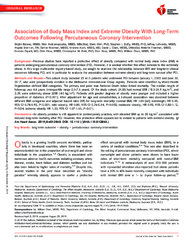Please use this identifier to cite or link to this item:
http://hdl.handle.net/11054/1462| Title: | Association of body mass index and extreme obesity with long‐term outcomes following percutaneous coronary intervention. |
| Author: | Biswas, S. Andrianopoulos, N. Dinh, D. Duffy, S. Leftkovits, J. Brennan, A Noaman, S. Ajani, A. Clark, D. Freeman, M. Oqueli, Ernesto Hiew, C. Reid, C. Stub, D. Chan, W. |
| Issue Date: | 2019 |
| Publication Title: | Journal of the American Heart Association |
| Volume: | 8 |
| Issue: | 21 |
| Start Page: | e012860 |
| Abstract: | Background Previous studies have reported a protective effect of obesity compared with normal body mass index (BMI) in patients undergoing percutaneous coronary intervention (PCI). However, it is unclear whether this effect extends to the extremely obese. In this large multicenter registry‐based study, we sought to examine the relationship between BMI and long‐term clinical outcomes following PCI, and in particular to evaluate the association between extreme obesity and long‐term survival after PCI. Methods and Results This cohort study included 25 413 patients who underwent PCI between January 1, 2005 and June 30, 2017, who were prospectively enrolled in the Melbourne Interventional Group registry. Patients were stratified by World Health Organization–defined BMI categories. The primary end point was National Death Index–linked mortality. The median length of follow‐up was 4.4 years (interquartile range 2.0‐7.6 years). Of the study cohort, 24.8% had normal BMI (18.5‐24.9 kg/m2), and 3.3% were extremely obese (BMI ≥40 kg/m2). Patients with greater degrees of obesity were younger and included a higher proportion of diabetics (P<0.001). After adjustment for age and comorbidities, a J‐shaped association was observed between different BMI categories and adjusted hazard ratio (HR) for long‐term mortality (normal BMI, HR 1.00 [ref]; overweight, HR 0.85, 95% CI 0.78‐0.93, P<0.001; mild obesity, HR 0.85, 95% CI 0.76‐0.94, P=0.002; moderate obesity, HR 0.95, 95% CI 0.80‐1.12, P=0.54; extreme obesity HR 1.33, 95% CI 1.07‐1.65, P=0.01). Conclusions An obesity paradox is still apparent in contemporary practice, with elevated BMI up to 35 kg/m2 associated with reduced long‐term mortality after PCI. However, this protective effect appears not to extend to patients with extreme obesity. |
| URI: | http://hdl.handle.net/11054/1462 |
| Resource Link: | https://ahajournals.org/doi/full/10.1161/JAHA.119.012860 |
| Internal ID Number: | 01442 |
| Health Subject: | LONG-TERM OUTCOME OBESITY PERCUTANEOUS CORONARY INTERVENTION |
| Type: | Journal Article Article |
| Appears in Collections: | Research Output |
Files in This Item:
| File | Description | Size | Format | |
|---|---|---|---|---|
| Association of body mass index and extreme obesity with long_term outcomes following percutaneous coronary intervention..pdf | Journal article | 521.14 kB | Adobe PDF |  View/Open |
Items in DSpace are protected by copyright, with all rights reserved, unless otherwise indicated.
